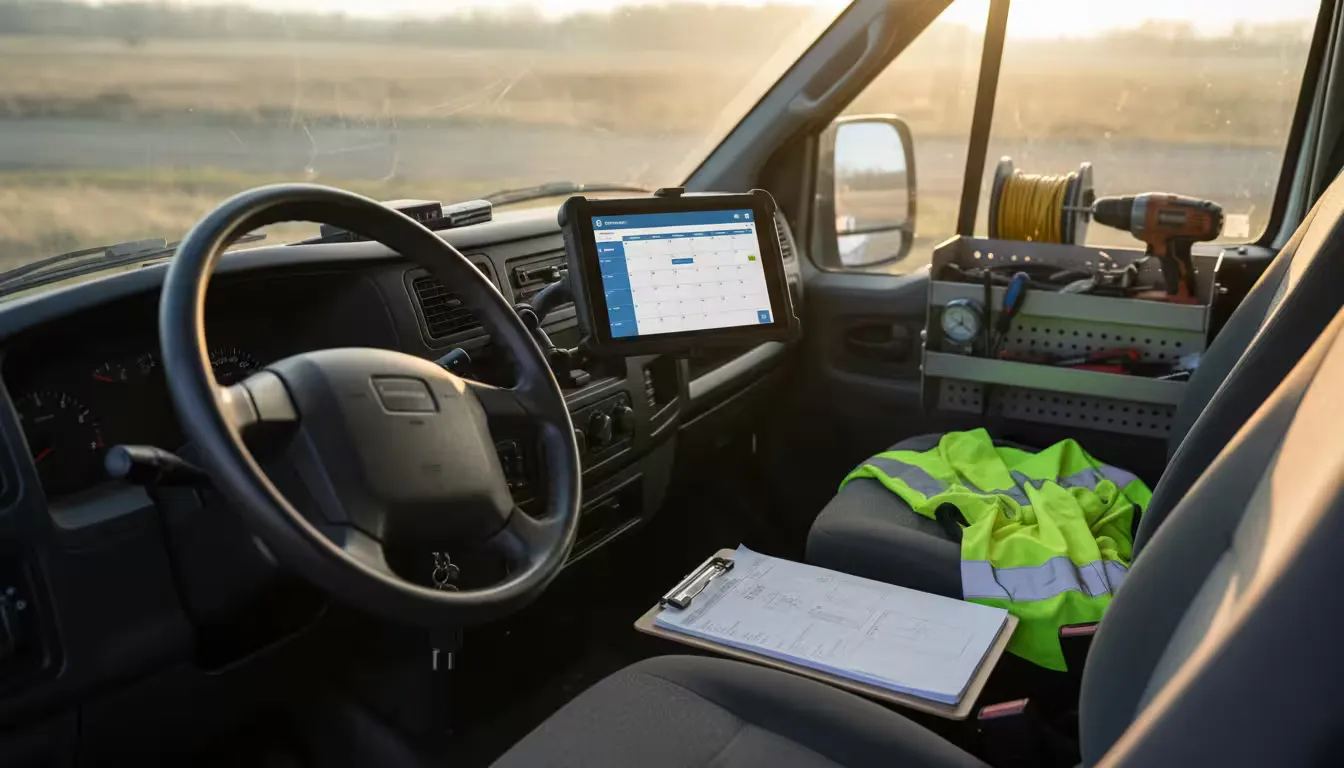· ShiftFlow Editorial Team · Glossary · 12 min read
What Is Covering a Shift? Definition, Examples & Guide
Learn what covering a shift means, proven methods for finding coverage quickly, best practices for fair shift coverage, and technology solutions that streamline the process for shift-based teams.

Covering a shift means finding a qualified replacement when a scheduled team member cannot work their assigned hours. This shift coverage process happens through peer swaps, manager assignments, or digital platforms that help businesses maintain operations during unexpected absences.
In short: Whether due to illness, emergencies, or scheduling conflicts, covering shifts requires clear policies that balance operational needs with fairness. The right approach maintains coverage while respecting team member availability and following legal requirements.
What does covering a shift mean?
Covering a shift is the process of finding a replacement worker when someone cannot fulfill their scheduled hours. It happens during illness, emergencies, scheduling conflicts, or planned swaps. The process requires identifying available workers, confirming they have necessary qualifications, and updating the schedule so everyone knows about the change.
Shift coverage maintains operational continuity when unexpected absences occur. Without effective coverage processes, businesses risk service disruptions, safety issues from understaffing, or burnout from overworking remaining team members. Good shift coverage systems protect both business operations and team member well-being.
Why do shifts need to be covered?
Several situations create the need for shift coverage in any operation. Understanding these reasons helps managers develop better policies and team members recognize when coverage is truly necessary.
Illness or injury affects the scheduled worker or their family members. When someone gets sick or needs to care for a sick child, they cannot safely or effectively perform their duties. This represents the most common reason for last-minute coverage needs.
Personal emergencies include car breakdowns, childcare failures, urgent appointments, or family crises that arise without warning. These situations demand immediate attention and make working impossible. While less predictable than scheduled time off, they happen regularly in any workforce.
Scheduling conflicts happen when calendar errors, overlapping commitments, or previously unknown obligations surface. Someone might discover they have a medical appointment they forgot to request off, or a school event might conflict with their shift. Clear time-off request processes help minimize these conflicts.
Voluntary shift trades allow people to adjust their hours for personal preferences, travel plans, or better work-life balance. These are planned in advance rather than reactive. When managed well, shift swaps increase team member satisfaction without affecting operations.
No-shows occur when someone fails to appear and fails to call. While less common than legitimate absences, they create the most urgent coverage needs since there is no advance warning. These situations may require disciplinary action alongside emergency coverage arrangements.
How do you find shift coverage quickly?
Businesses typically use one or more of these approaches when covering shifts.
Manager-directed coverage happens when the manager identifies available team members and assigns someone to cover the open shift. This method provides quick decisions and maintains clear control over who works which positions. However, it can feel arbitrary or unfair if managers consistently favor certain people or fail to distribute opportunities evenly across the team.
Shift swap systems let team members find their own replacements by trading shifts with colleagues who want different hours. This approach empowers autonomy, reduces manager workload, and often leads to mutually beneficial arrangements. It requires manager approval to verify the replacement has necessary qualifications and certifications. The main limitation is that swaps may not succeed in time if no one wants to trade.
Callout lists mean managers work through a roster of qualified team members, offering the shift in order until someone accepts. This systematic approach documents who was contacted, distributes opportunities fairly, and creates a clear record. The main downside is that calling people one-by-one takes significant time during emergencies when speed matters most.
Digital shift marketplaces through scheduling software allow team members to claim open shifts or arrange trades through a mobile platform. Technology makes the process fast, transparent, and accessible around the clock. Available workers get instant notifications and can accept shifts immediately without waiting for phone calls. The approach requires technology adoption and clear approval policies for which swaps need manager review.
On-call staff are designated workers who remain available specifically for short-notice coverage needs. This arrangement ensures reliability and faster response times when urgent needs arise. It typically requires paying on-call premiums based on hourly rate differentials and limits personal flexibility for those team members who must remain reachable.

What makes shift coverage work well?
Successful coverage systems share several key characteristics that balance business needs with team member fairness.
Clear written policies document advance notice requirements for planned time off, procedures for calling out sick, whether team members must find their own coverage, rules for approving swaps, consequences for no-shows without notice, and authorization procedures for overtime. Clear expectations prevent confusion and ensure everyone understands their responsibilities.
Qualified backup lists keep updated rosters showing who can work each position. Include certifications, skill levels, and availability restrictions so you can quickly identify eligible replacements during emergencies. Cross-training expands your pool of people who can fill different roles.
Coverage pattern tracking monitors who frequently picks up extra shifts and who regularly needs coverage. Use this data to recognize reliable contributors, identify attendance problems early, and verify opportunities are distributed fairly. Patterns reveal whether certain shifts consistently struggle to find coverage.
Quick response times matter because the faster you act on absence notifications, the more time you have to arrange coverage. Quick responses also reduce disruption to operations and demonstrate respect for the person who needs coverage.
Fair and transparent processes build trust even when coverage creates challenges. Systematic approaches feel equitable and predictable. However, true emergencies sometimes require immediate decisions without working through normal procedures. Communicate when and why you deviate from standard processes so the exception does not become expected.
Immediate communication about schedule changes means notifying everyone affected right away when coverage arrangements alter the schedule. Update all schedule locations—printed copies, digital calendars, mobile apps—so no one shows up confused or unprepared.
What legal issues affect shift coverage?
Overtime requirements apply when coverage pushes someone past standard hour thresholds, often 40 hours weekly under the Fair Labor Standards Act. Some states use daily overtime thresholds. Plan coverage to account for premium pay obligations or ensure workers who pick up shifts understand they may receive overtime.
Rest period requirements mandate minimum hours between shifts in some jurisdictions. You cannot ask someone to cover a shift if accepting would violate these requirements. Common standards require 8–12 hours between shift end and next shift start. According to OSHA guidance on extended work hours, fatigue from insufficient rest between shifts increases workplace injury risk. Verify local rules before arranging coverage.
Meal and break compliance means replacement workers receive the same breaks as originally scheduled workers. If the shift includes a 30-minute meal break, the person covering it gets that same break. Managers cannot eliminate breaks just because someone is covering last-minute.
Predictive scheduling laws in cities like Seattle, San Francisco, Philadelphia, and New York limit last-minute changes or require premium pay for short-notice shifts. According to the National Employment Law Project, predictive scheduling ordinances aim to provide workers with stable, predictable schedules. These laws may mandate advance notice periods, compensation for schedule changes, or both. Know your local requirements.
Voluntary versus mandatory coverage affects whether you can require team members to work unscheduled shifts. In most cases, employment agreements must explicitly allow mandatory coverage. You generally cannot force someone to accept an unscheduled shift unless on-call duties are part of their role.

How does technology improve shift coverage?
Modern scheduling tools streamline shift coverage processes in several ways that reduce manager workload and improve team member experience.
Mobile notifications alert available team members instantly when shifts become available, eliminating delays from phone tag. Workers see opportunities immediately rather than missing calls or waiting for voicemails.
Self-service claiming lets qualified workers pick up open shifts without manager intervention, speeding the process significantly. Team members can browse available shifts and accept them directly through mobile apps.
Automated callout lists contact team members in predetermined order until someone accepts, documenting all attempts automatically. This saves managers time and ensures fair distribution of opportunities.
Shift swap marketplaces create digital bulletin boards where workers can post shifts they want to trade or pick up shifts others are offering. This visibility increases the likelihood of successful trades without manager involvement in initial negotiations.
Qualification matching ensures only eligible workers can claim specific positions by filtering out people who lack necessary certifications or skills. This protects safety and quality while maintaining efficiency.
Coverage analytics provide reports on response times, which shifts struggle to find coverage, who frequently picks up shifts, and whether opportunities are distributed fairly across the team. These insights help managers improve policies and address problems proactively.
What challenges arise with shift coverage?
Cannot find anyone to cover happens when shifts are undesirable, notice is too short, or your available pool is too small. Solutions include maintaining larger pools of cross-trained team members through structured on-the-job training, developing relationships with temporary staffing agencies for true emergencies, or establishing on-call arrangements with dedicated workers. If certain shifts consistently struggle to attract coverage, investigate root causes like inconvenient timing or inadequate pay.
Same people always get asked first because managers naturally call reliable people, but this creates unfairness and may burn out your best performers. Rotate through callout lists systematically instead of calling favorites first. Digital shift marketplaces show opportunities to everyone simultaneously, eliminating favoritism in who sees available shifts.
Shift swaps create scheduling confusion when informal trades result in unqualified people working positions, double-booked shifts, or people forgetting they agreed to swaps. Require manager approval before finalizing any swap. Use scheduling software that tracks changes, sends notifications to everyone affected, and maintains accurate records. Establish clear deadlines such as requiring swap approval 24 hours before shifts start.
Frequent callouts from the same people signal underlying issues that need attention. Chronic absence may indicate childcare challenges, transportation difficulties, health problems, or disengagement. Have honest conversations about attendance patterns. Explore whether problems can be addressed through schedule adjustments or resources. Apply attendance policies consistently and document patterns if progressive discipline becomes necessary.
What etiquette applies to shift coverage?
For those requesting coverage, give as much advance notice as reasonably possible, even if policies only require less. Follow established procedures rather than informal arrangements that bypass managers. Be truthful about reasons—lying damages trust and makes future requests harder. Express genuine thanks to whoever provides coverage. Return the favor later when you can help others who need coverage.
For those providing coverage, respond promptly to requests even if you cannot help. A quick no lets managers keep searching rather than waiting for your reply. Only commit if you are certain you can fulfill it—agreeing and backing out later is worse than declining initially. Show up prepared when you agree to cover, including arriving on time and reviewing any specific duties for that shift.
For managers, express genuine appreciation to workers who provide coverage, especially on short notice. Apply policies consistently to everyone rather than having different standards for different people. Do not penalize legitimate absences like illness with formal discipline. Address chronic attendance issues privately through direct conversations rather than passive-aggressive scheduling.
Frequently Asked Questions
Can my employer force me to cover someone else’s shift? Generally no, unless your employment agreement includes mandatory coverage provisions. Most businesses cannot require team members to work unscheduled shifts without prior agreement. On-call arrangements are an exception where accepting coverage duties is part of the job.
Should I be paid extra for covering a shift on short notice? It depends on local laws. Some jurisdictions with predictive scheduling rules require premium pay for short-notice shifts. Overtime may apply if coverage pushes you over standard weekly hour thresholds, typically 40 hours under federal law.
What if I find coverage but my manager says no? Managers must ensure replacements are qualified and the swap does not create compliance issues. They may legitimately decline swaps that could cause safety concerns, violate labor laws like required rest periods, or put unqualified people in specialized positions.
How much notice should I give when I need coverage? As much as possible. Follow your workplace policy for planned time off—often two weeks or more. For illness or emergencies, notify your manager immediately so they have maximum time to arrange coverage. Early notification increases the likelihood of finding someone.
Am I responsible for finding coverage when I’m sick? Policies requiring you to find your own coverage for illness may be problematic or illegal in some jurisdictions. Being sick is generally the employer’s responsibility to manage, not yours. Consult local regulations if your employer requires this, especially if it delays necessary medical care.
What happens if nobody accepts an open shift? Managers may need to adjust operations by reducing service levels, work the shift themselves as a shift supervisor, call in on-call staff, or contact temporary agencies for emergency coverage. In extreme cases, operations may need to close or reduce capacity until coverage is found.

Managing shift coverage effectively
Covering shifts is an inevitable reality in shift-based operations. The difference between chaotic scrambling and smooth operations comes down to clear policies, effective communication tools, and fair processes that balance business needs with team member realities.
Whether you use manager-directed assignments, peer swaps, digital marketplaces, or a combination, success requires clarity about who does what, consistency in applying policies, and consideration for everyone involved. Technology streamlines the mechanical process of finding available people, but human judgment handles the nuances of specific situations like genuine emergencies versus chronic issues.
Modern workforce management tools make it easier to notify available team members instantly, track who contributes coverage regularly through clear duty rosters, and maintain fairness across your team based on documented work availability. Explore how schedule rotation generators and digital platforms can support your coverage process, reduce manager workload, and create more transparency for everyone involved.




